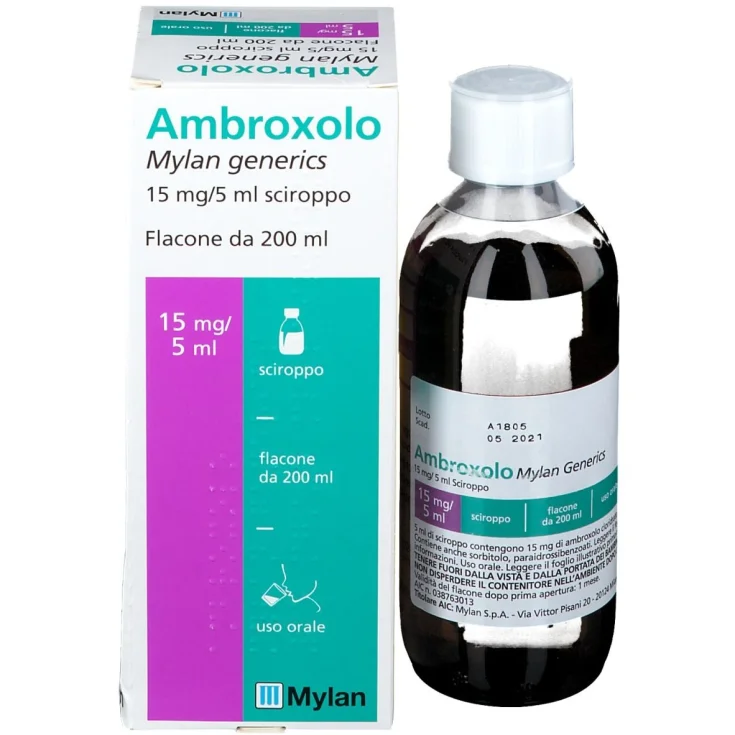Ambroxol Mylan 15mg / 5ml Syrup 200ml

- Brand: MYLAN SpA
- Product Code: 038763013
- EAN:
- Availability: In Stock (evaso in 24 ore)
- 3 items
for 7,89€ each - 4 items
for 7,73€ each - 5 items
for 7,57€ each
Ambroxol Mylan 15mg / 5ml
Syrup
Composition :
5 ml of syrup contain: Active ingredient: ambroxol hydrochloride mg 15 Excipients: glycerol, sorbitol, methyl-para-hydroxy-benzoate, propyl-para-hydroxy-benzoate. For the full list of excipients, see section 6.1.
Excipients
Sorbitol, propyl-para-hydroxy-benzoate, methyl-para-hydroxy-benzoate, glycerol, raspberry essence, ammonium glycyrrhizinate, purified water.
Therapeutic indications
Treatment of secretion disorders in acute and chronic bronchopulmonary affections.
Contraindications
Hypersensitivity to the active substance or to any of the excipients. Severe hepatic and / or renal disorders. Generally contraindicated in pregnancy and lactation (see section 4.6). The drug is contraindicated in children under 2 years of age.
Dosage
5 ml of syrup correspond to 15 mg of ambroxol hydrochloride. The enclosed measuring cup has graduated marks at 10ml, 7.5ml, 5ml, 2.5ml. Adults and adolescents At the start of treatment: 10 ml 2-3 times a day, then 5 ml 3 times a day. Children from two to five years 2.5 ml 3 times a day. Children over five years of age 5 ml 2-3 times a day. At the beginning of the treatment the dose can be increased or even doubled in the opinion of the doctor. The syrup should be taken with meals.
Warnings and Precautions
Ambroxol should be administered with caution in patients with peptic ulcer. Very rarely, severe skin lesions such as Stevens-Johnson syndrome and Lyell syndrome have been observed at the same time as the administration of mucolytic substances such as ambroxol. Most of these could be explained by the severity of underlying disease or other concomitant medications. If new skin or mucosal lesions occur, consult your doctor immediately and stop treatment with ambroxol as a precaution. Do not use for prolonged treatments. Mucolytics can induce bronchial obstruction in children less than 2 years of age. In fact, the drainage capacity of the bronchial mucus is limited in this age group, due to the physiological characteristics of the respiratory tract. They should therefore not be used in children less than 2 years of age (see section 4.3). The medicine contains sorbitol, therefore the product should be taken with caution by people with rare hereditary fructose intolerance problems. Sorbitol may also have a moderate laxative effect; the caloric value of sorbitol is 2.6 kcal / g (a 5 ml dose of syrup contains almost 2 grams of sorbitol). The medicine also contains p-hydroxybenzoates which can cause allergic reactions (usually delayed type). Finally, the medicine contains glycerol which can cause headache, stomach upset and diarrhea.
Interactions
Following administration of ambroxol the concentrations of antibiotics (amoxicillin, cefuroxime, erythromycin) in bronchopulmonary secretions and saliva are increased. No interactions with other medicinal products have been reported.
Side effects
Episodes of diarrhea have been commonly observed. Nausea, vomiting, other mild gastrointestinal disturbances, allergic reactions have been reported uncommonly. In rare cases, heartburn (heartburn), dyspepsia (digestive difficulties), rash (erythema), urticaria, angioedema have been reported. Extremely rare cases of anaphylactic reactions (including anaphylactic shock) have been reported. Bronchial obstruction: frequency unknown.
Pregnancy and breastfeeding
Ambroxol crosses the placental barrier. Animal studies have not shown any direct or indirect harmful effects on pregnancy, embryonal / fetal development, parturition or postnatal development. Although preclinical studies and extensive clinical experience have not shown any harmful effects to the fetus after the 28th week of gestation, it is recommended that normal precautions be taken when taking medications during pregnancy. Especially during the first trimester it is not recommended to take ambroxol. The drug is excreted in breast milk, therefore the use of ambroxol is not recommended during breastfeeding. However, no negative effect on the infant is conceivable.






